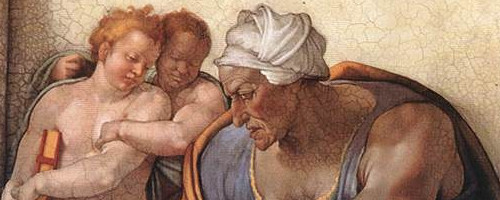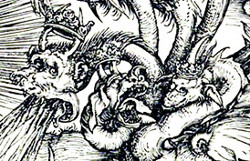
He never used to have dreams until the night he murdered his mother. Now the nightmares came thick and fast. Hordes of winged ants swarmed across his face. His wife clawed at him from beyond the grave and dragged him into a place of suffocating darkness. He awoke, drenched in sweat, and discovered his bedroom doors and the doors of his ancestor’s tomb had flung themselves open during the night. Even now he tried to laugh it off. He made jokes about his singing voice while the seas retreated from the shores of Egypt and it rained blood onto the slopes of extinct volcanoes. At last his friends and allies forsook him. Finally fearing for his life, he fled on horseback. The Earth quaked as he rode and lightning flashed across his face as if the spirits of the dead were tearing the world apart to get at him. Then the assassins came. He saw them approaching in the distance and urged his last friends to take his life. They refused. Groaning in anguish he grabbed a dagger, shouted “What an artist perishes in me!” and drove the dagger into his throat. Nero Caesar was finally dead.1
But for how long? Even while he was still alive astrologers predicted Nero’s fall and said that he would afterwards become the king of Jerusalem2. Is it any surprise people refused to believe it was all over after he died? Some waited eagerly for Nero to come out of hiding and take revenge on his enemies3. Others said Nero was making for the East to claim his promised kingdom. The Sibylline Oracles, utterances from the possessed mouthpieces of Apollo, declared:
To the men of Jerusalem also shall come an evil storm-blast of war from Italy, and shall lay waste the great temple of God, when putting their trust in folly they shall cast away godliness and do hateful deeds of blood before the temple; and then shall a great king from Italy flee away like a deserter, unseen, unheard of, beyond the ford of Euphrates, after he has polluted his hands with the hateful murder of his mother, doing the deed with wicked hand. And many round his throne shall drench the soil of Rome with their blood, when he has fled beyond the land of Parthia.4
And then, one day, it actually happened. Nero came back.

It was A.D. 69, the Year of the Four Emperors, in which four men fought tooth and nail for the Roman empire in the wake of Nero’s demise. The worst thing that could possibly happen was for Nero to resurface and take it all back again. At this time a man arrived in Asia Minor claiming to be Nero. He was, in fact, a slave from Pontus with a turkey-neck, a lyre and a boatload of moxie. With these he managed to convince people that he was the real Nero. After all, they had only ever seen a dented, smudgy version of the emperor on coins. This guy looked tolerably like Nero, right? And he could play the lyre — who else could it be? This false Nero surrounded himself with a gang of deserters, vagrants and fly-by-nights and began to throw his weight around. The party ended when “Nero” made the mistake of intercepting three trierarchs from Rome, one of whom happened to be the new governor of Galatia and Pamphylia. They stormed “Nero’s” stronghold and killed him outright, then took the body back to Rome where everyone gawked at the “savage countenance” that was so like the real Nero’s it caused amazement wherever it went5.
This impostor from Pontus was only one of three known “false Neros” who stalked the ancient world. We know less about the others, but the second arose sometime between A.D. 79 and 81. An Asian man called Terentius Maximus, another chunky lyre-player, announced that he was Nero and started storming his way across Asia towards Italy. He crossed the Euphrates and won over the support of the Parthians6. I’d say good old Terentius was doing pretty well for himself, but that’s the last we hear of his expedition. There isn’t a single mention of what happened to him. A third false Nero arose in about 88, no fewer than 20 years after the real Nero died. The real Nero would have been about 50 years old. We only have the barest mention of this Nero, just that he also made a hit with the Parthians until the Romans managed to extradite him7.
Nero’s influence didn’t just extend beyond his own death but long after he could possibly still be alive. We don’t know exactly how many other false Neros there might have been but it is implied there were more we don’t know about. The Nero myth was so powerful even the Christians seized on it, probably still remembering a little incident involving a lion, an arena and Nero watching on with a big bag of popcorn. But the Christians didn’t just claim Nero would come back — they claimed he’d come back as the Antichrist.
The most damning source for Antichrist Nero (by Catholic standards) is none other than the “infallible” Bible. In Revelation John describes the beast’s horns and heads and crowns, then blurts out, “one who understands can calculate the number of the beast, for it is a number that stands for a person. His number is six hundred and sixty-six.”8 Biblical scholars agree that this person only makes sense as a contemporaneous figure in the late first century A.D. The most accepted reading of “666” is as a numerological transformation of Nero’s name. Nero in Greek is Καῖσαρ Νερών, which transliterates into Hebrew נרון קסר. When you add the numeric value of the Hebrew letters you arrive at none other than 666.9
Once The Bible laid it on the line, the rest of Christian myth followed. The Sibylline Oracles go on to say:

Then one with the letter fifty10 shall be king, a fell dragon breathing out grievous war, who shall lift his hand against his own people to slay them, and shall spread confusion, playing the athlete, charioteer, assassin, a man of many ill-deeds; he shall cut through the mountain between two seas and stain it with blood; yet he shall vanish to destruction; then he shall return, making himself equal to God: but God shall reveal his nothingness.11
Nero’s status as Antichrist became more and more in-grained. Even as late as the 5th Century Augustine of Hippo wrote:
[The Apostle Paul] alluded to Nero, whose deeds already seemed to be as the deeds of Antichrist. And hence some suppose that he shall rise again and be Antichrist. Others, again, suppose that he is not even dead, but that he was concealed that he might be supposed to have been killed, and that he now lives in concealment in the vigor of that same age which he had reached when he was believed to have perished, and will live until he is revealed in his own time and restored to his kingdom.12
So basically, ZOMBIE NERO. The myth is even called “Nero Redivivus” — Nero alive again. Our favorite cack-handed, turkey-necked, theatrical matricide lies in wait, perfectly preserved in “the vigor of that same age which he had reached when he was believed to have perished”. A body washes up on the beach with strange bite-marks in the skin. Birds fall out of the sky. People all over the world feel their bones sag under the weight of a nameless dread. Beware. Don’t go out. Zombie Nero walks abroad tonight.
Notes
-
This story, while obviously dramatized by my own pen, paraphrases the events and omens reported by Suetonius’ Nero XLVI–XLIX and Cassius Dio LXIII.26–29. ↩
-
Nero XL. ↩
-
Nero LVII. ↩
-
Sibylline Oracles, IV.115–124. ↩
-
This account is from Tacitus’ The History II.8–9. ↩
-
Zonaras XI.18, as cited by Pappano. ↩
-
Nero LVII. ↩
-
Revelation 13:18. ↩
-
Charles, 218. ↩
-
N (i.e. Nero) is the Greek numeral for 50. ↩
-
Sibylline Oracles, V.30–33. ↩
-
Augustine of Hippo, City of God XX.19.3. ↩
Bibliography
-
Augustine. The City of God. Trans. Marcus Dods. From Nicene and Post-Nicene Fathers, First Series vol. 2. Ed Philip Schaff. Buffalo: Christian Literature Publishing, 1887. Web. 12 June 2012. <http://www.newadvent.org/fathers/1201.htm>.
-
Bate, H.N. The Sibylline Oracles: Books III–V. New York: The Macmillan Company, 1918. Print.
-
Charles, Robert Henry. “Revelation, Book of”. The Encyclopædia Britannica. 11th ed. Vol. 23. 1911. Print.
-
Chrysostom, Dio. Dio Chrysostom. Trans. J.W. Cohoon & H. Lamar Crosby. Harvard University Press, 1932–1951. Web. 12 June 2012. <http://penelope.uchicago.edu/Thayer/E/Roman/Texts/Dio_Chrysostom/home.html>.
-
Dio, Cassius. Roman History. Trans. Earnest Cary. Harvard University Press, 1914–1917. Web. 12 June 2012. <http://penelope.uchicago.edu/thayer/e/roman/texts/cassius_dio/home.html>.
-
The New American Bible. United States Conference of Catholic Bishops. 2002. Web. 26 June 2012. <http://www.vatican.va/archive/ENG0839/_INDEX.HTM>.
-
Pappano, Albert Earl. “The False Neros“. The Classical Journal 32.7 (1837): 385–392. Print.
-
Suetonius. The Lives of the Twelve Caesars. Trans. Alexander Thomson. Philadelphia: Gebbie & Co., 1889. Web. 12 June 2012. <http://www.perseus.tufts.edu/hopper/>.
-
Tacitus. The Complete Works of Tacitus. Trans. Alfred John Church, William Jackson Brodribb. New York: Random House, 1942. Web. 12 June 2012. <http://www.perseus.tufts.edu/hopper/>.